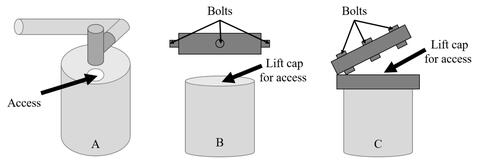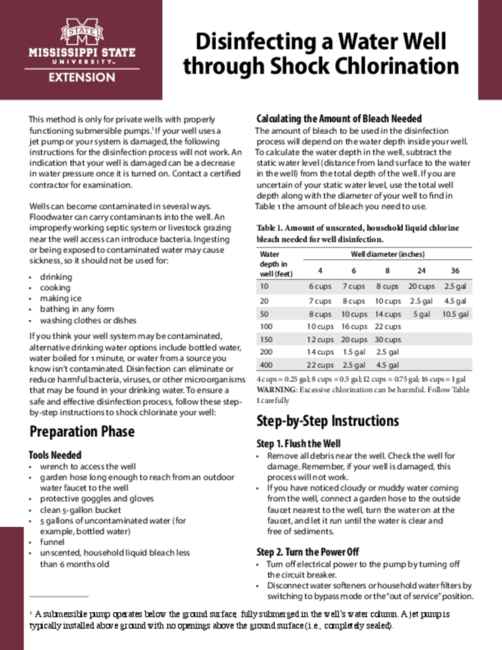P3398
Disinfecting a Water Well through Shock Chlorination
This method is only for private wells with properly functioning submersible pumps.1 If your well uses a jet pump or your system is damaged, the following instructions for the disinfection process will not work. An indication that your well is damaged can be a decrease in water pressure once it is turned on. Contact a certified contractor for examination.
Wells can become contaminated in several ways. Floodwater can carry contaminants into the well. An improperly working septic system or livestock grazing near the well access can introduce bacteria. Ingesting or being exposed to contaminated water may cause sickness, so it should not be used for:
- drinking
- cooking
- making ice
- bathing in any form
- washing clothes or dishes
If you think your well system may be contaminated, alternative drinking water options include bottled water, water boiled for 1 minute, or water from a source you know isn’t contaminated. Disinfection can eliminate or reduce harmful bacteria, viruses, or other microorganisms that may be found in your drinking water. To ensure a safe and effective disinfection process, follow these step-by-step instructions to shock chlorinate your well:
Preparation Phase
Tools Needed
- wrench to access the well
- garden hose long enough to reach from an outdoor water faucet to the well
- protective goggles and gloves
- clean 5-gallon bucket
- 5 gallons of uncontaminated water (for example, bottled water)
- funnel
- unscented, household liquid bleach less than 6 months old
Calculating the Amount of Bleach Needed
The amount of bleach to be used in the disinfection process will depend on the water depth inside your well. To calculate the water depth in the well, subtract the static water level (distance from land surface to the water in the well) from the total depth of the well. If you are uncertain of your static water level, use the total well depth along with the diameter of your well to find in Table 1 the amount of bleach you need to use.
|
Water depth in well (feet) |
Well diameter (inches) |
||||
|---|---|---|---|---|---|
|
4 |
6 |
8 |
24 |
36 |
|
|
10 |
6 cups |
7 cups |
8 cups |
20 cups |
2.5 gal |
|
20 |
7 cups |
8 cups |
10 cups |
2.5 gal |
4.5 gal |
|
50 |
8 cups |
10 cups |
14 cups |
5 gal |
10.5 gal |
|
100 |
10 cups |
16 cups |
22 cups |
||
|
150 |
12 cups |
20 cups |
30 cups |
||
|
200 |
14 cups |
1.5 gal |
2.5 gal |
||
|
400 |
22 cups |
2.5 gal |
4.5 gal |
||
4 cups = 0.25 gal; 8 cups = 0.5 gal; 12 cups = 0.75 gal; 16 cups = 1 gal
WARNING: Excessive chlorination can be harmful. Follow Table 1 carefully
Step-by-Step Instructions
Step 1. Flush the Well
- Remove all debris near the well. Check the well for damage. Remember, if your well is damaged, this process will not work.
- If you have noticed cloudy or muddy water coming from the well, connect a garden hose to the outside faucet nearest to the well, turn the water on at the faucet, and let it run until the water is clear and free of sediments.
Step 2. Turn the Power Off
- Turn off electrical power to the pump by turning off the circuit breaker.
- Disconnect water softeners or household water filters by switching to bypass mode or the “out of service” position.
Step 3. Open the Well
- For a well seal (Figure 1A), remove the threaded well plug for access; for a well cap (Figure 1B) or sanitary cap (Figure 1C), remove the bolts from the cap and lift it for access.
- If your well system does not look like the options below, call a contractor for further assistance.

Figure 1. Different well access possibilities: A) threaded well plug; B) well cap; C) sanitary cap.
Step 4. Mix Bleach Water Solution
- Fill the 5-gallon bucket about three-quarters full with bottled water.
- Look back at Table 1 to determine how much bleach is needed.
- Add the bleach to the bucket of water.
- Using the funnel, pour the bleach solution into the threaded well plug or well casing. Be careful not to splash or spill the solution.
Step 5. Recirculate the Chlorinated Water
- Turn on the circuit breaker to the pump.
- Connect a garden hose to the outdoor faucet nearest to the well.
- For a well seal, place the funnel into your well’s access point and put the garden hose into the funnel. For well caps and covers, place the garden hose into the well casing.
- Turn the water on and let it run for 30 minutes to circulate the bleach within the well.
Step 6. Run Chlorine Solution Through All Faucets
- Run the chlorinated water through the outside spigots, and work your way inside the house by turning on each tap one at a time until you smell bleach. Once you smell bleach, turn the tap off.
- Repeat this step for both hot and cold taps, toilet and shower/bath taps, and outside faucets.
- Leave the chlorinated water in the plumbing for a minimum of 8 hours or overnight.
Step 7. Flush the Chlorinated Water
- Connect a garden hose to an outdoor faucet and run the water until you no longer smell chlorine.
- Keep the running water away from your septic system, landscaping, and bodies of water.
- Turn off the garden hose once you can no longer smell chlorine.
- Begin turning on each fixture inside the house one at a time until the chlorine smell is no longer present.
Step 8. Disinfect and Reconnect Water Treatments
- Disinfect home water softeners or household filters according to the manufacturer’s instructions, and then reconnect those devices. Do not drink the water until it has been tested.
- Send a water sample to a lab to ensure it is safe to use.
IMPORTANT: Before using the water for drinking, cooking, making ice, or preparing food, have the water tested by a certified laboratory. If disinfection attempts fail, the well may need to be cleaned before it is disinfected again. Contact a contractor or local health department for help.
For More Information
Mississippi State Department of Health Water Supply Certification: In-State Participating Labs
This procedure is based on well-disinfection protocols from the Florida Department of Health, Minnesota Department of Health, Virginia Tech Cooperative Extension, Texas A&M Agrilife Extension, and Texas Commission on Environmental Quality.
1. A submersible pump operates below the ground surface, fully submerged in the well’s water column. A jet pump is typically installed above ground with no openings above the ground surface (i.e., completely sealed).
Publication 3398 (POD-10-24)
By Drew M. Gholson, PhD, Assistant Extension Professor and Coordinator, National Center for Alluvial Aquifer Research, Delta Research and Extension Center; and Jason R. Barrett, PhD, Associate Extension Professor and Associate Director, Water Resources Research Institute.
The Mississippi State University Extension Service is working to ensure all web content is accessible to all users. If you need assistance accessing any of our content, please email the webteam or call 662-325-2262.
